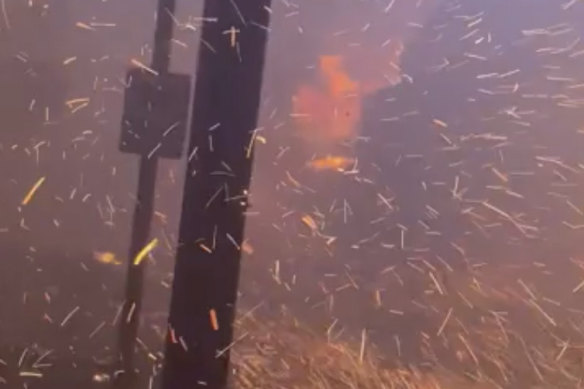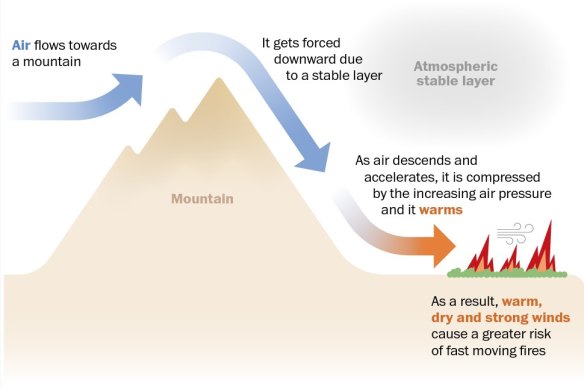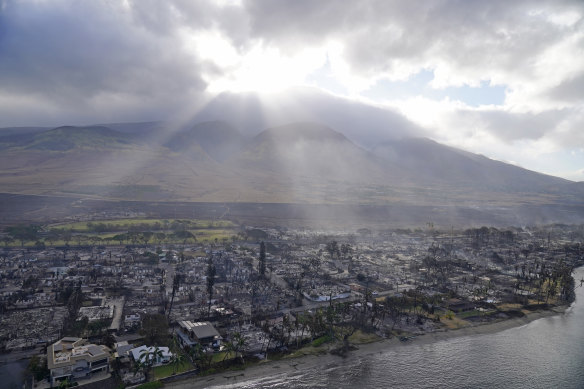
Save articles for later
Add articles to your saved list and come back to them any time.
Raging, wind-whipped wildfires this week have killed at least 36 people in Hawaii and destroyed much of the Maui town of Lahaina.
While months of drought set the stage for the fires, it was the confluence of two weather systems – high pressure to the north and Category 4 Hurricane Dora to the south – that incited the winds that spread the blazes at devastating speeds.
In this photo provided by Bosco Jr Bae flames from the wildfires fill the sky on Front Street in Lahaina, Hawaii.Credit: AP
Wildfires are relatively common on the Hawaiian islands.
About 0.5 per cent of Hawaii’s land area burns each year, “equal to or greater than the proportion burned of any other US state,” according to the Hawaii Wildfire Management Organisation.
This week’s firestorm, however, has been uncommon in its ferocity, destroying hundreds of buildings, forcing mass evacuations and cutting power to as many as about 13,000 customers.
A bit of meteorology explains what sparked the violent winds behind Hawaii’s fast-moving firestorm.
Months of drought set the stage for the fires by drying out vegetation, which has become more flammable in recent decades because of the spread of nonnative grasses.
But it’s been unusually strong winds that have caused the fires to spread out of control so quickly. Gusts as high as 107 km/h were reported in Maui County, and up to 131 km/h in Hawaii and Honolulu counties.
The gusty winds are the result of a large difference in pressure – more than 60 millibars – between high pressure to the north of the islands and low pressure associated with Dora passing to the south.
Differences in atmospheric pressure create wind, and gusts become intense when the differences are steep over small distances.
While it’s not unusual for high pressure to set up north of Hawaii and to usher in strong east to west breezes, the added presence of Dora intensified the winds by increasing the pressure difference over the region.
The breezes sweeping over the islands were not only extremely gusty but also were unusually dry.
As the arid winds swept over the West Maui Mountains, they forced air to accelerate down the west side of the mountains.
These are known as “downslope” winds, which compress and heat the air as they descend and dry it out even more. Such winds increase the risk of wildfires, and gusts can quickly fan flames.
A combination of weather systems and geography drove raging winds over a drought-plagued landscape.Credit: Washington Post
“We’ve seen this time and time again: downslope wind storms are drivers of the highest impact fires,” tweeted Neil Lareau, a professor of meteorology and a wildfire expert at the University of Nevada at Reno.
These dry downslope winds have different names in different parts of the world.
In Southern California, they’re called Santa Ana winds, which are a common culprit in many of the state’s worst wildfires.
In Alaska, and along the Rocky Mountains, they are known as the Foehn or Chinook winds.
Wildfire wreckage is seen in Lahaina, Hawaii.Credit: AP
It’s not the first time that hurricane winds have aided the development of Hawaiian wildfires.
In 2018, downslope winds from Hurricane Lane helped to initiate multiple fires on Maui and Oahu.
Hurricane Lane passed much closer to Hawaii – about 240 km to the south – which was close enough to trigger flooding and fires at the same time.
“With strong high pressure to the north of the state and Lane advancing from the south, sustained winds of around 30 mph [48 km/h] and gusts in excess of 50 mph [80 km/h] blew across western Maui. Driven by these winds, three wildfires rapidly charred 2000 acres and destroyed 21 residential structures, causing over $US4 million ($6 million) in reported damage,” the National Hurricane Centre wrote in a report.
Because Dora passed much farther away, about 800 km south of Hawaii, not all meteorologists agree on the extent of Dora’s role in fanning this week’s deadly flames.
But the consensus is that the hurricane, which has travelled about 7000 km across the Pacific, played a role.
The Washington Post
Get a note directly from our foreign correspondents on what’s making headlines around the world. Sign up for the weekly What in the World newsletter here.
Most Viewed in World
From our partners
Source: Read Full Article


